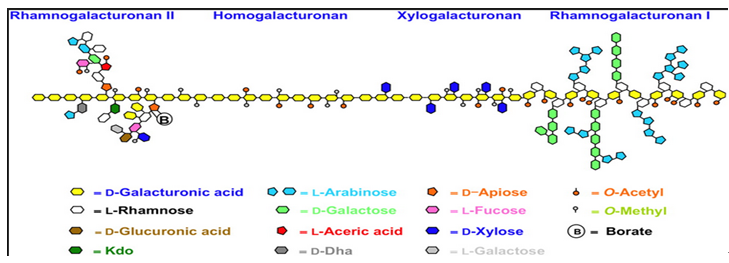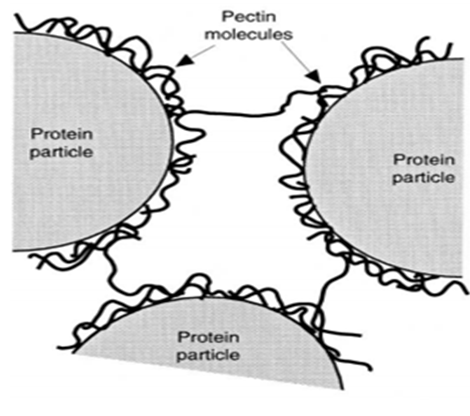Q:What is the structure of pectin?
A:Pectin is mainly composed of Homogalacturonan region (HG), Rhamnogalacturonan-I (RGI) and Rhamnogalacturonan-II (RGII). Among them, HG accounts for more than 60%, and it is a long-chain macromolecular substance obtained by linking D-galacturonic acid through α-1,4 glycosidic bonds. The outstanding feature of the pectin structure is that the main chain is long and the side chains are short.

Q:How does pectin stabilize protein matters?
A:Pectin mainly stabilizes the protein by electrostatic repulsion on the surface of casein by adsorption on the surface of the casein. The negative charge carried by the pectin can change the whole casein micelle from positively charged to negatively charged by electrostatic induction. Mutual exclusion avoids the occurrence of cohesion, and steric hindrance also plays a role but is not a decisive factor.

Q:What is the difference of composition between soluble soy polysaccharides and pectin?
A:Please see below figure:
Sugar compositions (mol%) |
| GalA | Rha | Ara | Gal | Fuc | Glc | Xyl |
SSPS | 18.5 | 5.7 | 20.7 | 49.8 | 1.3 | 1.1 | 2.9 |
Pectin | 85.3 | 1.9 | 4.5 | 6.3 | 0.6 | 0.3 | 1.1 |
Q:What is the difference between soluble soy polysaccharides and pectin in the applicable pH range, solubility, viscosity and tolerability?
A:Please refer to below:
a. Comparison of applicable pH range
In the range of pH 3.0-4.2, the protein stability of soluble soy polysaccharides is gradually enhanced when the pH decreases. When the pH is less than 3.5, the protective effect of HM pectin on casein is weakened, the stability of the milk system is decreased, and the protein stability of pectin is gradually weakened.
b. Solubility comparison
Soluble soy polysaccharides can be dissolved in cold and hot water, and temperature has little effect on its solubility.
Pectin is soluble in hot water and slightly soluble in cold water. It must be dissolved under the action of strong agitator and insoluble in organic solvents such as ethanol.
c. Viscosity comparison
The viscosity of soluble soy polysaccharides is very low. The viscosity of 1% aqueous solution (at 25 ° C) is about 3 mPa s. General polysaccharides will form a gel network structure under low concentration. While, no gel is formed when the concentration of soluble soy polysaccharides reaches 10%. And it can be formulated into more than 30% solution.
The viscosity of pectin is relatively high. At 25℃, the viscosity of 1% pectin aqueous solution is about 30 mPa s. HM pectin can form a gel under a certain concentration of sugar and acid conditions. LM pectin requires a certain concentration of calcium ions to form gel.
d. Endurance
Soluble soy polysaccharides has high endurance to heat, acid and salt. It shows stable state in the range of pH 2-12, and its viscosity shows good reversibility in this pH range. Even under a strong acid environment (pH 2), soluble soy polysaccharides did not form a gel. Soluble soy polysaccharides has strong glycosidic bond, and the structure remains stable and color changes lightly after treatment at pH 3-6 and 120 °C for 15 min. In addition, when adding different concentration of metal cations, such as NaCl, KCl, CaCl2, to 10% soluble soy polysaccharides water solution, the viscosity of soluble soy polysaccharides does not change substantially.
For pectin, when temperature is raised under low pH, the degumming reaction and degradation of the polymer will occur simultaneously, and the deesterification is particularly rapid. When pH is 4, it can reach the most stable situation. When pH is close to neutral (pH 5 ~ 6), HM pectin is stable only at room temperature. At higher temperature, due to β-deesterification, its gel properties will rapidly lost. Pectin has negative charge and can form precipitate with metal ions such as copper and aluminum.
Q:Does soluble soybean polysaccharide and pectin affect fermentation?
A:Soluble soy polysaccharides does not affect the fermentation of yoghurt. It can be directly added and then fermented. HM pectin affects the fermentation of yoghurt and cannot be added directly before fermentation.
Q:Can soluble soy polysaccharides be used alone or replace pectin in dairy products?
A:For different products, such as dairy drinks, flavored fermented milk etc., soluble soy polysaccharides can be used alone in low protein (less than 0.5%) beverage products, such as Calpis water, chilled fermented milk drinks. For dairy drinks and flavor fermented milk, it is recommended to blend soluble soy polysaccharides with pectin.